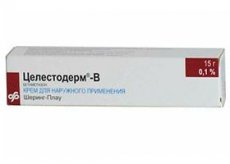Medical expert of the article
New publications
Preparations
Celestoderm-B
Last reviewed: 03.07.2025

All iLive content is medically reviewed or fact checked to ensure as much factual accuracy as possible.
We have strict sourcing guidelines and only link to reputable media sites, academic research institutions and, whenever possible, medically peer reviewed studies. Note that the numbers in parentheses ([1], [2], etc.) are clickable links to these studies.
If you feel that any of our content is inaccurate, out-of-date, or otherwise questionable, please select it and press Ctrl + Enter.

The drug Celestoderm-B belongs to the pharmacological group of adrenal cortex hormones; ATC code D07AC01 – corticosteroids for topical use in dermatology.
Other trade names: Celestone valerate, Akriderm, Beloderm, Betliben, Betnovate, Kuterid.
 [ 1 ]
[ 1 ]
Indications Celestoderm-B
Celestoderm-B is used in the treatment of dermatitis (atopic, allergic, contact, solar), seborrhea, eczema, neurodermatitis, pruritus, psoriasis (with exudation), discoid lupus erythematosus, lichen sclerosus, exfoliative erythroderma, and diaper rash with oozing.
 [ 2 ]
[ 2 ]
Release form
Ointment and cream (tubes of 5 and 15 g).
Pharmacodynamics
The drug Celestoderm-V contains a pharmacologically active substance – the synthetic GCS betamethasone (in the form of betamethasone 17-valerate), which reduces the intensity of inflammation, hyperemia and itching of the skin, as well as exudation of all layers of the epidermis and dermis.
The therapeutic effect is based on the fact that corticosteroids stimulate intracellular synthesis of lipocortin-1, thereby reducing the activity of phospholipase A2, inflammatory mediators, COX 1 and COX 2, leukocytes. In addition, betamethasone reduces the synthesis of histamine and inhibits the release of phagocytes, T-lymphocytes and other immunocompetent cells into the inflammation site; helps strengthen the capillary walls.
Pharmacokinetics
In the absence of damage to the skin, no more than 14% of Celestoderm-B is adsorbed into the blood (in the case of skin damage and extensive areas of inflammation, this proportion is higher).
About half of betamethasone binds to peptides; biotransformation of the drug occurs in the liver; Celestoderm-B is excreted from the body in urine and feces.
Dosing and administration
Celestoderm-B is applied locally by lubricating the skin areas with a small amount of ointment or cream twice a day; application of an occlusive dressing is permitted.
 [ 8 ]
[ 8 ]
Use Celestoderm-B during pregnancy
The use of Celestoderm-B by pregnant (and breastfeeding) women, as well as other GCS, is undesirable. The drug can be prescribed only in case of extreme necessity.
Contraindications
Celestoderm-V is contraindicated for use in dermatological pathologies of an infectious nature: acne, papular lichen, candidiasis, mycosis, impetigo. This product cannot be used in oncological diseases of the skin. The drug is not used for children under one year of age.
Side effects Celestoderm-B
Possible side effects of Celestoderm-B include: allergy in the form of redness, itching and rash on the skin; dryness (in folds - maceration), burning and depigmentation of the skin at the site of application; appearance of stretch marks; inflammation of the hair follicles. Long-term use of the ointment or cream can cause thinning of the epidermis and skin atrophy.
Overdose
Overdose of this drug causes increased side effects, and in such cases its use should be discontinued.
 [ 9 ]
[ 9 ]
Storage conditions
Store at temperature < +25°C.
Shelf life
36 months.
Attention!
To simplify the perception of information, this instruction for use of the drug "Celestoderm-B" translated and presented in a special form on the basis of the official instructions for medical use of the drug. Before use read the annotation that came directly to medicines.
Description provided for informational purposes and is not a guide to self-healing. The need for this drug, the purpose of the treatment regimen, methods and dose of the drug is determined solely by the attending physician. Self-medication is dangerous for your health.

